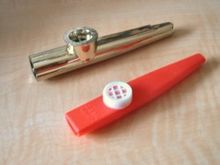Kazoo
The kazoo [ kəˈzuː ] (English also bazoo, bazooka, gazooka, gazoota ) is a small membranophone that belongs to the singing drums ( Mirlitons ). Speaking to it or singing it out causes a membrane to vibrate, changing the tone of your own voice.
Kazoos often come in a characteristic shape: an approximately 10–12 cm long, slightly rectangular tube that tapers towards the end, but is still open. A round, half-open holder sits on top of the tube, under which a parchment membrane or fish skin membrane rests loosely. There are kazoos in all shapes and sizes. The membrane holder can be attached on top or on the side.
Kazoos are made from various materials. The most common and cheapest is plastic, which emphasizes the typical squeaky sound. Metal kazoos sound lighter and are more stable, but are a bit more expensive. Wooden kazoos are relatively noble and have a warm and soft sound.
It works in a similar way to the old technique of comb-blowing, with a slightly saxophone-like sound . A kazoo is not a wind instrument. It is not blown into it, but sung into it. The small parchment membrane is made to vibrate with your own voice . The membrane does not produce its own tone, it only amplifies and changes that of the singing voice. The result is a quacky, nasal , distorted sound. The pitch depends solely on the note sung into it.
Singing drums and musical instruments modified in sound by membranes have existed in Africa for centuries. While the instrument was used in early jazz in jug bands or spasm bands as a melody voice and there were real kazoo orchestras in the 1920s , it currently only plays a role as an effect instrument or musical gag.
literature
- Anthony C. Baines, Paul Oliver, Martin Kirnbauer: Kazoo . In: Grove Music Online, 2001
- Ekkehard Jost : Kazoo. In: Wolf Kampmann (Ed.), With the assistance of Ekkehard Jost: Reclams Jazzlexikon . Reclam, Stuttgart 2003, ISBN 3-15-010528-5 , p. 644.
Web links
- Peter Jensen Brown: Bazoo, Kazoo, Bazooka - from Playful Instrument to Instrument of War (a History and Etymology of Kazoo and Bazooka). Early Sports and Pop Culture History Blog, May 1, 2017
- How To Play Kazoo on kazoos.com (English)

